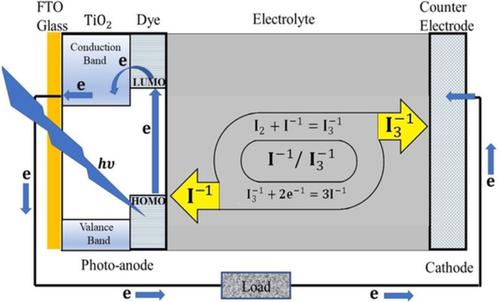当前位置:
X-MOL 学术
›
Int. J. Quantum Chem.
›
论文详情
Our official English website, www.x-mol.net, welcomes your
feedback! (Note: you will need to create a separate account there.)
Time‐dependent density functional theory investigations on structural modification in carbazole‐based organic photosensitizers to improve electron injection in dye‐sensitized solar cell
International Journal of Quantum Chemistry ( IF 2.3 ) Pub Date : 2020-04-22 , DOI: 10.1002/qua.26253 Abdul Majid 1 , Maryam Sana 1 , Salah Ud‐Din Khan 2 , Naeem Ahmad 3
International Journal of Quantum Chemistry ( IF 2.3 ) Pub Date : 2020-04-22 , DOI: 10.1002/qua.26253 Abdul Majid 1 , Maryam Sana 1 , Salah Ud‐Din Khan 2 , Naeem Ahmad 3
Affiliation

|
The time‐dependent density functional theory approach, implemented at hybrid‐B3LYP, GGA‐PBE, and density functional‐based tight binding levels of theory, was used to model photoinjection in organic dye/TiO2 quantum dot to explore the prospects of improvement of dye‐sensitized solar cell (DSSC). The photosensitizer used in this study consisted of six carbazole‐based organic dyes, a cyanoacrylic acid group as an acceptor and an oligothiophene π ‐bridge spacer. The modifications were made in the dyes by increasing the length of the spacer by adding thiophene and oxadiazole rings at different positions of the donor‐acceptor bridge. The structural variations appeared to alter the electronic and optical properties of dyes studied via energy levels and excitation spectra. The UV‐Vis spectra calculated for all the dyes in solvents exhibited a red shift in spectral peaks with an increase in the polarity of the solvents. The findings of the study pointed toward the indirect photoinjection of the dye‐(TiO2)96 complex for six different dyes. The substitution of the oxadiazole ring at the center and addition of a thiophene ring at the edge of the spacer produced two dyes that exhibited the lowest injection energies of 0.11 and 0.17 eV, along with the regeneration energies of 1.18 and 1.12 eV, respectively. The dyes reported here may have promising applications in photoanode for enhancing the performance of DSSC.
中文翻译:

基于时间的密度泛函理论研究咔唑基有机光敏剂的结构修饰,以改善染料敏化太阳能电池的电子注入
在杂化-B3LYP,GGA-PBE和基于密度泛函的紧密结合理论水平下实施的基于时间的密度泛函理论方法,用于对有机染料/ TiO 2量子点中的光注入进行建模,以探索改善有机染料/ TiO 2量子点的前景。染料敏化太阳能电池(DSSC)。本研究中使用的光敏剂由六种咔唑基有机染料,一个氰基丙烯酸基团和一个低聚噻吩π组成。-桥接垫片。通过在供体-受体桥的不同位置添加噻吩和恶二唑环来增加间隔子的长度,从而对染料进行了修饰。结构变化似乎改变了通过能级和激发光谱研究的染料的电子和光学性质。计算出的所有染料在溶剂中的UV-Vis光谱显示出随着溶剂极性的增加,光谱峰出现红移。该研究的结果表明了染料(TiO 2)96的间接光注入。六种不同染料的配合物。中心的恶二唑环的取代和间隔基边缘的噻吩环的添加产生了两种染料,它们的最低注入能量分别为0.11和0.17 eV,以及再生能量分别为1.18和1.12 eV。本文报道的染料可能在光阳极中具有增强DSSC性能的有前途的应用。
更新日期:2020-04-22
中文翻译:

基于时间的密度泛函理论研究咔唑基有机光敏剂的结构修饰,以改善染料敏化太阳能电池的电子注入
在杂化-B3LYP,GGA-PBE和基于密度泛函的紧密结合理论水平下实施的基于时间的密度泛函理论方法,用于对有机染料/ TiO 2量子点中的光注入进行建模,以探索改善有机染料/ TiO 2量子点的前景。染料敏化太阳能电池(DSSC)。本研究中使用的光敏剂由六种咔唑基有机染料,一个氰基丙烯酸基团和一个低聚噻吩π组成。-桥接垫片。通过在供体-受体桥的不同位置添加噻吩和恶二唑环来增加间隔子的长度,从而对染料进行了修饰。结构变化似乎改变了通过能级和激发光谱研究的染料的电子和光学性质。计算出的所有染料在溶剂中的UV-Vis光谱显示出随着溶剂极性的增加,光谱峰出现红移。该研究的结果表明了染料(TiO 2)96的间接光注入。六种不同染料的配合物。中心的恶二唑环的取代和间隔基边缘的噻吩环的添加产生了两种染料,它们的最低注入能量分别为0.11和0.17 eV,以及再生能量分别为1.18和1.12 eV。本文报道的染料可能在光阳极中具有增强DSSC性能的有前途的应用。











































 京公网安备 11010802027423号
京公网安备 11010802027423号